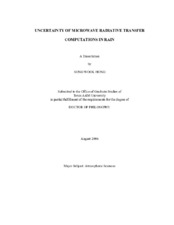| dc.description.abstract | Currently, the effect of the vertical resolution on the brightness temperature (BT)
has not been examined in depth. The uncertainty of the freezing level (FL) retrieved
using two different satellites' data is large. Various radiative transfer (RT) codes yield
different BTs in strong scattering conditions.
The purposes of this research were: 1) to understand the uncertainty of the BT
contributed by the vertical resolution numerically and analytically; 2) to reduce the
uncertainty of the FL retrieval using new thermodynamic observations; and 3) to
investigate the characteristics of four different RT codes.
Firstly, a plane-parallel RT Model (RTM) of n layers in light rainfall was used for
the analytical and computational derivation of the vertical resolution effect on the BT.
Secondly, a new temperature profile based on observations was absorbed in the Texas
A&M University (TAMU) algorithm. The Precipitation Radar (PR) and Tropical
Rainfall Measuring Mission (TRMM) Microwave Imager (TMI) data were utilized for
the improved FL retrieval. Thirdly, the TAMU, Eddington approximation (EDD), Discrete Ordinate, and backward Monte Carlo codes were compared under various view
angles, rain rates, FLs, frequencies, and surface properties. The uncertainty of the BT
decreased as the number of layers increased. The uncertainty was due to the optical
thickness rather than due to relative humidity, pressure distribution, water vapor, and
temperature profile. The mean TMI FL showed a good agreement with mean bright band
height. A new temperature profile reduced the uncertainty of the TMI FL by about 10%.
The differences of the BTs among the four different RT codes were within 1 K at the
current sensor view angle over the entire dynamic rain rate range of 10-37 GHz. The
differences between the TAMU and EDD solutions were less than 0.5 K for the specular
surface.
In conclusion, this research suggested the vertical resolution should be considered
as a parameter in the forward model. A new temperature profile improved the TMI FL in
the tropics, but the uncertainty still exists with low FL. Generally, the four RT codes
agreed with each other, except at nadir, near limb or in heavy rainfall. The TAMU and
the EDD codes had better agreement than other RT codes. | en |


